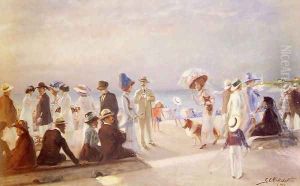Firmin Marcelin Michelet Paintings
Firmin Marcelin Michelet was a French artist born on October 8, 1817, in Pontoise, France. His life spanned much of the 19th century, a period that witnessed significant changes in the art world with the rise of movements like Romanticism, Realism, and Impressionism. Michelet, however, is not widely recognized as a leading figure in any of these movements, and as a result, detailed information about his life and career is not as readily available as it is for his more famous contemporaries.
Michelet's artistic journey began in the traditional academic setting of the École des Beaux-Arts in Paris, where many French artists received their formal training. He was a student of Michel Martin Drolling, a respected history painter, which provided Michelet with a strong foundation in the neoclassical methods that were favored at the time. This education would have included rigorous instruction in drawing, anatomy, and the study of classical sculptures and masterworks.
Though Michelet's name is not commonly known, he participated in the Salon, the official art exhibition of the Académie des Beaux-Arts in Paris. The Salon was the primary showcase for artists to gain recognition, and Michelet exhibited his work there on several occasions. His submissions were typically in the genre of history painting, which was highly regarded during his era.
Throughout his career, Michelet would have navigated the shifting landscape of French art, which saw the decline of neoclassical and history painting and the rise of new, more modern approaches. However, he did not seem to have made the same impact as some of his peers. The lack of extensive documentation on Michelet's works and their influence suggests that while he was a competent artist, he did not achieve significant fame or notoriety.
Michelet's death occurred on February 10, 1891, in Paris. Despite the lack of widespread recognition, Michelet's life and work are part of the rich tapestry of 19th-century French art. His contributions, like those of many artists of the period, offer insight into the broader context of the art world at the time—a world grappling with tradition and innovation amidst a rapidly changing society.
